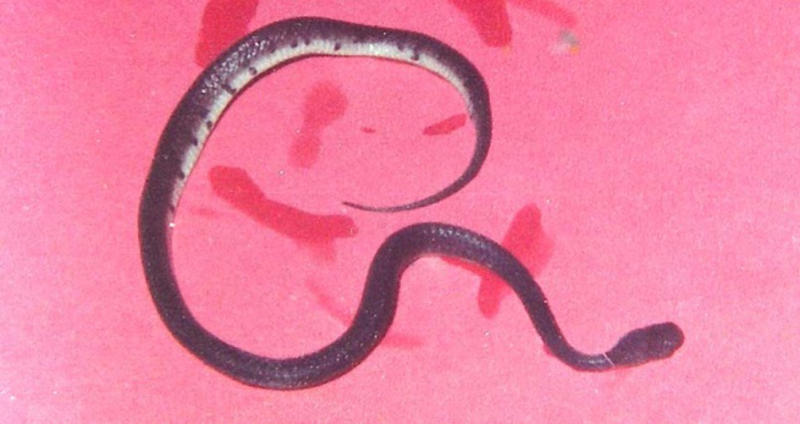SINGAPORE - Last seen in 1847, a recent sighting of a lined blind snake, also known by its scientific name Ramphotyphlops lineatus, has caused a buzz among reptile and amphibian enthusiasts in Singapore.
The reptile's body was found along a bike trail at Bukit Timah Nature Reserve by Dr John van Wyhe, a senior lecturer at the National University of Singapore, on Sept 16.
At 52cm, the snake is believed to be the longest specimen of its kind.
The discovery has changed the snake's status from "indeterminate" to "extant", now that its existence has been definitively recorded here in modern times.
Last seen in Singapore in 1847, the find has been heralded as a significant rediscovery.
Here are five other animals that have been discovered or rediscovered in Singapore in recent years, which show the country's nature areas remain thriving habitats for biodiversity.
Two-toned Blackwater Mud Snake

A black snake with a brownish-yellow underbelly, the 40cm-long reptile was discovered in September 2014 by staff from the National Parks Board's (NParks') National Biodiversity Centre in the Nee Soon Swamp Forest during a biodiversity study.
The Nee Soon Swamp Forest is located within the Central Catchment Nature Reserve.
Very little is known about the snake's population size due to its recent discovery here.
The blackwater mud snake is listed as a data deficient species on the International Union for Conservation of Nature (IUCN) Red List of Threatened Species, with limited information available on its population trend.
The elusive species, which resides in forests and wetlands, is native to Singapore, Indonesia and peninsular Malaysia.
Smooth Slug Snake

Last seen in 1978 in the vicinity of Mandai Zoo, a carcass of the smooth slug snake was rediscovered as roadkill at Old Upper Thomson Road by a member of the Nature Society (Singapore).
The slug snake is listed as a species of least concern on the IUCN Red List, which means it is not under threat. The slug snake can be found in peat swamps and black water environments within South-east Asia.
Like the two-toned blackwater mud snake, the slug snake is also a non-poisonous species.
Neptune's Cup Sponge

Thought to be globally extinct, the marine organism, Neptune's Cup Sponge, was rediscovered in Singapore in 2011 by marine scientists.
The scientists, who found two sponges in 2011, could relocate only one of the two due to low visibility in Singapore's sedimentary waters.
In 2016, however, four divers including scientists from the coastal and marine branch at National Parks Board's (NParks) National Biodiversity Centre found the missing sponge off St John's Island.
Nicknamed "Neppie", the sponge was rediscovered along with two more of the same species, fuelling efforts to build the organism's population in Singapore's waters.
The cup-like sponges were once abundant in Singapore until overharvesting by museums, private collectors and individuals for use as a bathtub for infants, nearly wiped them out.
Wasp-mimic

It might look like a hornet, but it will not sting.
A species of flower fly last seen in Singapore 200 years ago, the wasp-mimic, also known by its scientific name Milesia vespoides, was rediscovered on Pulau Ubin in 2019.
The mimic has no sting, although it wears the hallmark yellow-and-black jacket of a hornet, a type of wasp.
This fear by association helps it avoid predators, scientists say.
Flower flies like the mimic visit flowers as adults, just like bees and wasps, and often mimick them in appearance.
The flower flies also act as pollinators, transferring pollen from flower to flower and helping plants flourish.
Eosmallota Singularis (Flower Fly)

Unlike the wasp-mimic, this flower fly is no bigger than the length of a human fingernail, dull-coloured and easily overlooked.
Rediscovered in 2017 by researchers at the Bukit Timah Nature Reserve, the flower fly is thought to be rarer than the wasp-mimic, and have been previously found in the forests of Malaysia and Borneo.
Both the wasp-mimic and the flower fly were last seen by British naturalist Alfred Russel Wallace in the 1850s.
Wallace had collected their holotypes- the first and most important specimens of their kind, which scientists studying the species refer back to - when he was in Singapore between 1854 and 1856, before taking them back to Britain.
The holotypes are currently at the Natural History Museum in London.
Sources: International Union for Conservation of Nature (IUCN) website - https://www.iucn.org/, The Straits Times


